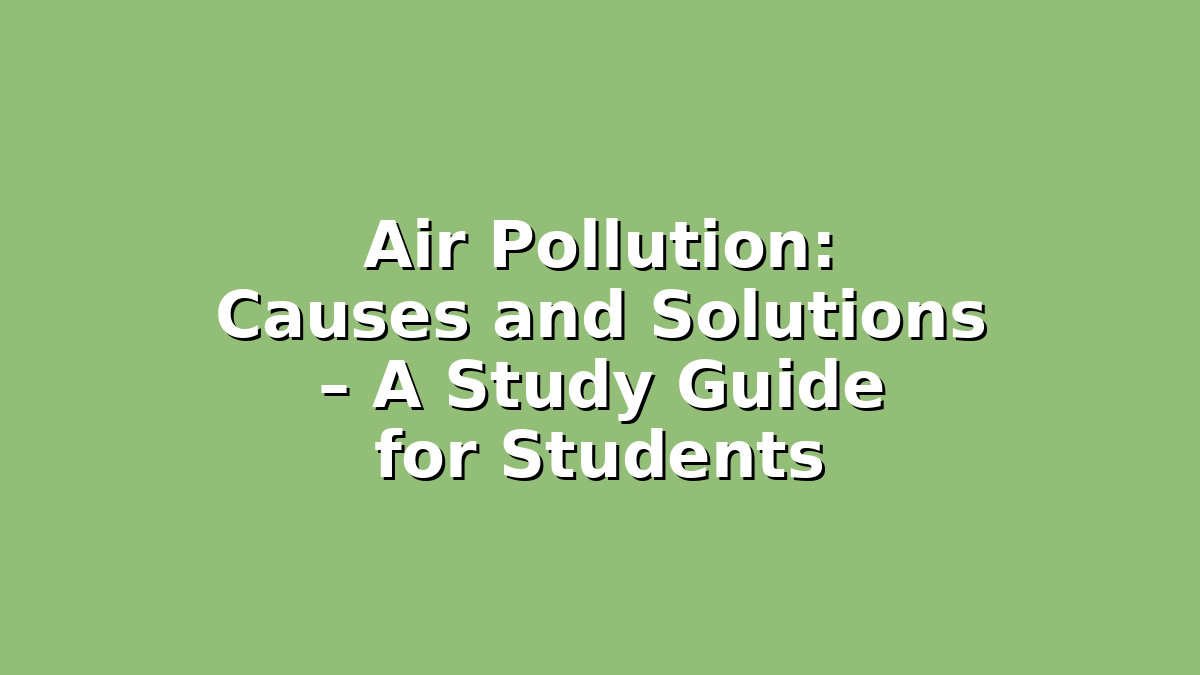Air pollution is one of the most pressing environmental issues today, affecting millions of people worldwide. For students preparing for exams or looking to enhance their knowledge, understanding air pollution’s causes and solutions is not only important for academic success but also for becoming responsible global citizens. This guide will break down the essentials of air pollution in a clear, study-friendly way, and provide practical tips to help you learn effectively.
Introduction
Air pollution refers to the presence of harmful substances in the atmosphere that can negatively impact human health, ecosystems, and the climate. These pollutants come from various sources, both natural and man-made. As students, you might encounter questions on this topic in science, geography, or environmental studies exams. Knowing the causes and solutions to air pollution will help you develop well-rounded answers and improve your critical thinking skills.
In this article, we will explore the main causes of air pollution, discuss effective solutions, and share study tips tailored to help you grasp and remember these concepts for your exams.
—
1. Understanding the Causes of Air Pollution
To tackle any problem effectively, you need to understand its root causes. Air pollution arises mainly from human activities, although some natural sources contribute as well.
Human-Caused Sources:
– Industrial Emissions: Factories release pollutants like sulfur dioxide (SO₂), nitrogen oxides (NOₓ), and particulate matter into the air. These come from burning fossil fuels such as coal and oil.
– Vehicle Exhaust: Cars, trucks, and buses emit carbon monoxide (CO), nitrogen oxides, and hydrocarbons, which contribute to smog and poor air quality.
– Agricultural Activities: The use of fertilizers and pesticides releases ammonia and other chemicals, which can pollute the air.
– Burning of Waste: Open burning of garbage produces toxic gases and particulate matter.
Natural Sources:
– Volcanic Eruptions: Release ash and gases like sulfur dioxide.
– Wildfires: Produce smoke and particulate matter.
– Dust Storms: Carry large amounts of dust and sand into the atmosphere.
Study Tip:
Create flashcards with the types of pollutants and their sources. On one side, write the pollutant (e.g., nitrogen oxides), and on the other, its source and effects. Reviewing these regularly will improve recall and help you link cause and effect during exams.
—
2. Exploring the Solutions to Air Pollution
After understanding the causes, it’s crucial to learn about the solutions that can mitigate air pollution. These solutions often involve changes at individual, community, and governmental levels.
Technological Solutions:
– Use of Clean Energy: Shifting to renewable energy sources like solar, wind, and hydro reduces emissions from power plants.
– Improved Vehicle Technology: Electric and hybrid cars produce fewer emissions. Installing catalytic converters in conventional vehicles also helps reduce pollutants.
– Industrial Filters: Factories can install scrubbers and filters to capture harmful gases before they reach the atmosphere.
Policy and Regulation:
– Governments can enforce stricter emission standards for vehicles and industries.
– Implementing public transportation systems reduces the number of vehicles on the road.
– Promoting green urban planning to increase green spaces that absorb pollutants.
Individual Actions:
– Using public transport, biking, or walking instead of driving.
– Reducing waste and avoiding open burning.
– Participating in tree-planting and environmental awareness campaigns.
Study Tip:
Make a mind map linking “Solutions” to categories like technology, policy, and personal actions. Visual aids like this help organize information logically, making it easier to write structured answers in exams.
—
3. Study Strategies to Master Air Pollution Topics
Understanding complex topics like air pollution requires organized study habits and strategies tailored for exam success.
Active Reading and Note-Taking:
When studying from textbooks or online resources, highlight key points about causes and solutions. Summarize each paragraph in your own words to ensure comprehension.
Practice Answering Past Questions:
Look for previous exam questions on air pollution and practice writing full answers. Time yourself to simulate exam conditions and work on presenting clear, concise information.
Group Study and Discussion:
Discussing air pollution topics with classmates can deepen your understanding. Explaining concepts aloud helps reinforce your memory and exposes you to different perspectives.
Use Real-Life Examples:
Relate what you learn to current events, such as air quality reports in your city or news about environmental policies. This contextual knowledge makes your answers more relevant and impressive.
Balanced Study Schedule:
Break your study time into focused sessions, dedicating specific slots to environmental topics. Combine reading, writing, and quizzing yourself for varied engagement.
Study Tip:
Create a summary sheet with cause-and-effect chains (e.g., vehicle emissions → increase in nitrogen oxides → smog formation → health problems). This makes revision quick and effective before exams.
—
Conclusion
Air pollution is a multifaceted problem with diverse causes and solutions. As a student, mastering this topic is achievable by breaking it down into manageable sections: understanding causes, exploring solutions, and applying effective study techniques. Remember, learning about air pollution is not only about passing exams but also about becoming informed individuals who can contribute to a cleaner, healthier planet.
Stay motivated, use the study tips shared in this article, and approach your revision with confidence. With consistent effort, you’ll not only excel in your exams but also gain valuable knowledge to make a positive impact in the future.
Good luck with your studies!
—

Responses